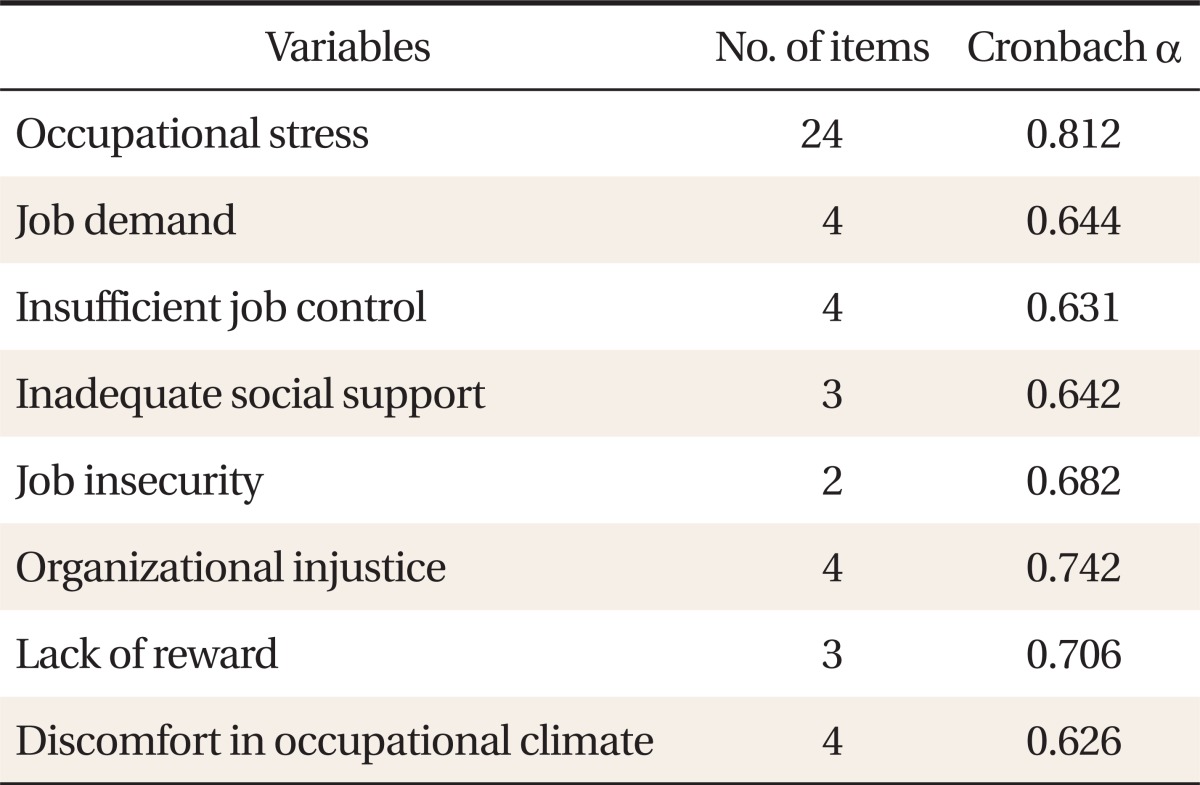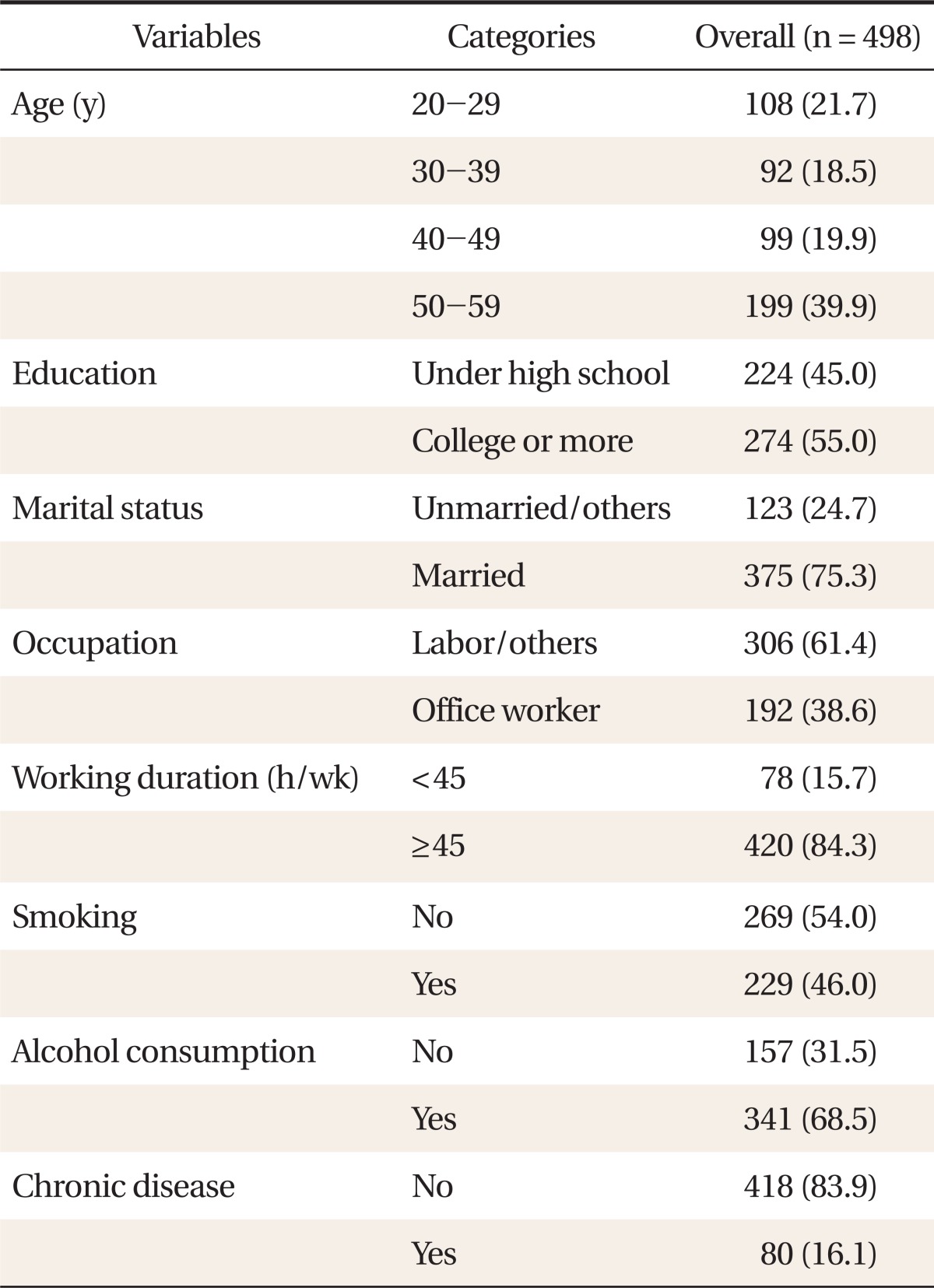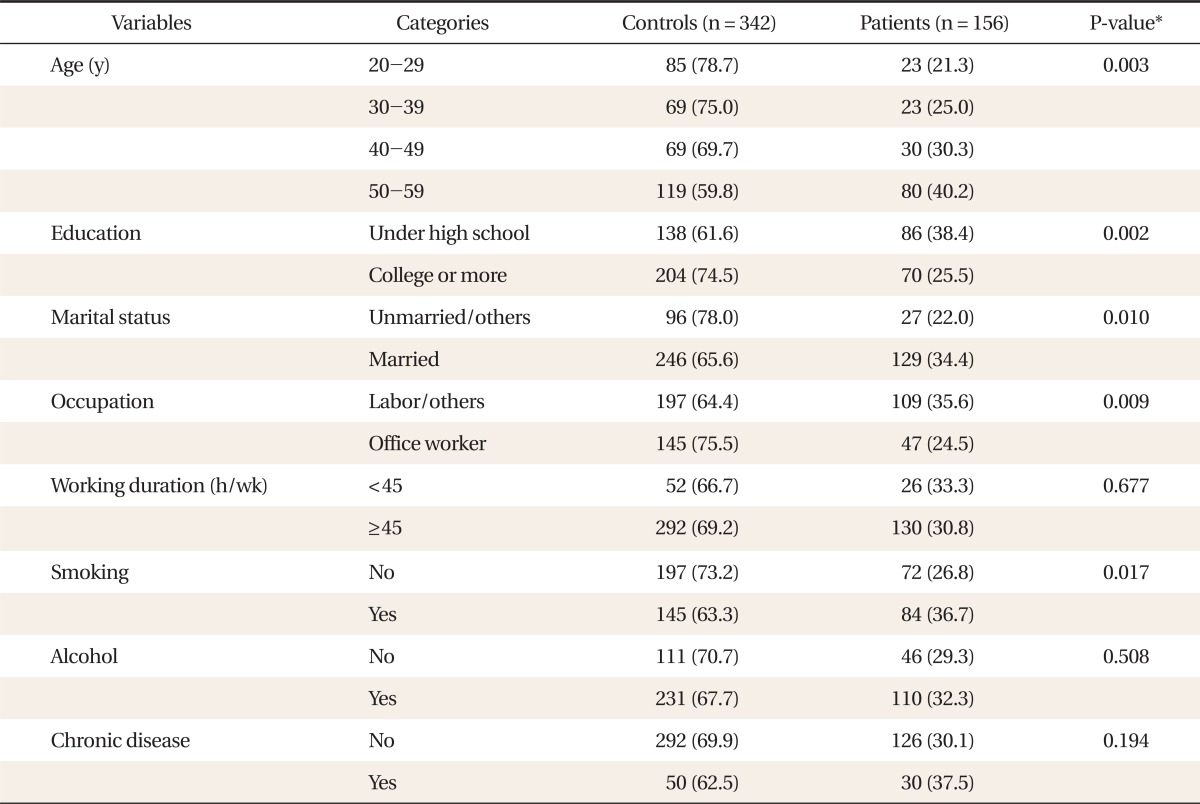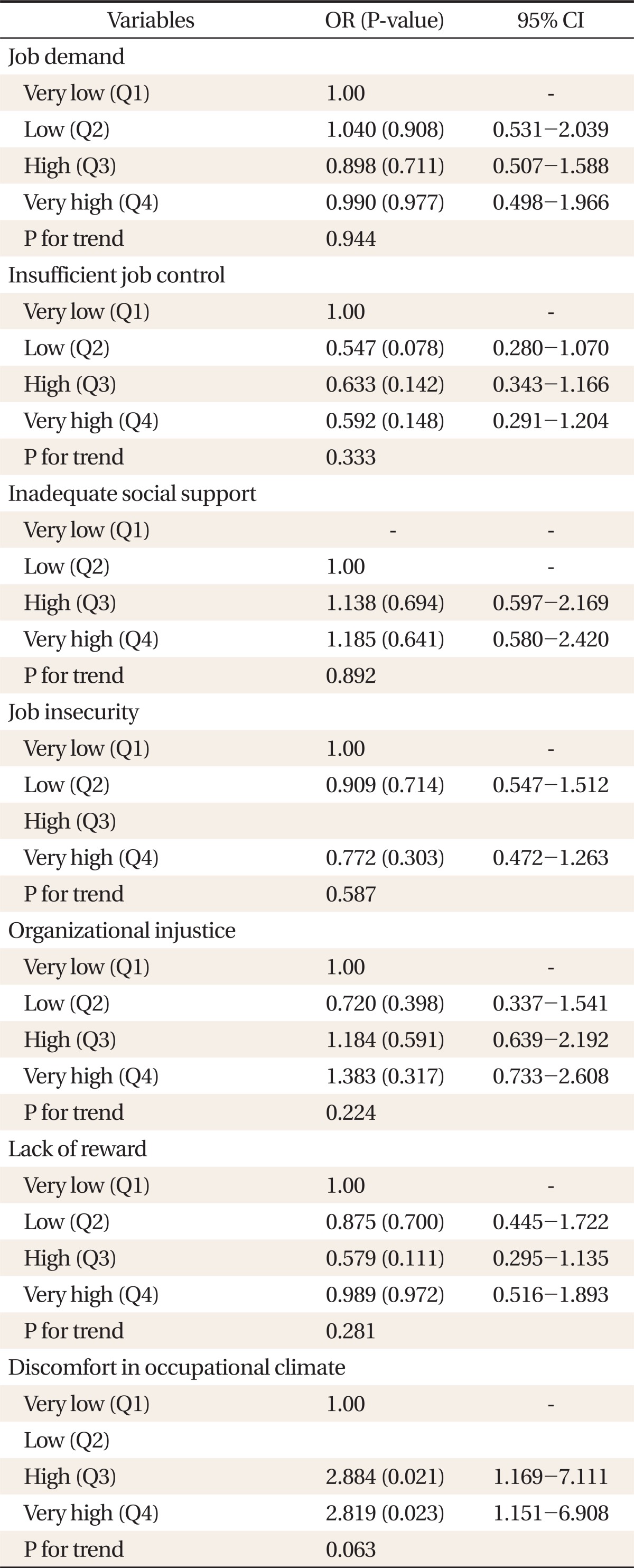Relationship between Occupational Stress and Gastric Disease in Male Workers
Article information
Abstract
Background
Physical and mental health of workers is threatened due to various events and chronic occupational stress. This study was conducted to investigate the relationship between occupational stress and gastric disease in male workers of the shipbuilding industry.
Methods
Occupational stress measured among a total of 498 workers of a shipbuilding firm who visited the hospital for health examination using the Korean Occupational Stress Scale (KOSS)-short form, and the relationship between sociodemographic factors, health-related behaviors, occupational stress, and gastric disease, and the distribution of occupational stress by sociodemographic factors in the gastric disease group was examined.
Results
There was no significant association between gastric disease and total occupational stress score and its seven sub-factors. The analysis showed that risk of gastric disease was significantly higher in the Q1 group in which the stress caused by occupational discomfort among seven sub-factors was lowest than that in the Q4 group (odds ratio, 2.819; 95% confidence interval, 1.151 to 6.908). Analysis only on the gastric disease group showed that the stress score of laborers was higher in the four sub-factors than that of office workers (P < 0.05). Analysis on educational background showed that the scores of the three sub-factors were lower in subjects who's highest level of education was high school (P < 0.01).
Conclusion
This study suggests that it is necessary to improve the culture of Korean collectivism in the workplace and to manage the occupational stress in the low-educated and laborers. It is recommended for future studies to confirm the causal relationship between occupational stress and gastric disease by large scale studies using a KOSS which appropriately reflects workplace culture.
INTRODUCTION
It has been shown that stress acts as one of the major factors causing various chronic diseases.1) Stress is known as a factor contributing to psychological diseases such as depression, anxiety, and insomnia, as well as physical illness, including headache, chronic fatigue, gastric ulcer, hypertension, diabetes, and arteriosclerosis.2,3)
Due to the gradual specialization of modern society, the physical and mental health of modern people is being threatened from various events, chronic occupational stress, and fatigue.4,5) Occupational stress may be defined as a physical and emotional reaction generated when occupational requirements do not match ability, resources, or desire of a worker.6)
In Korea, although it was not a nationwide sample survey as in Europe or Japan, a survey was performed on 6,977 workers from 254 companies. From the survey, there were 331 (5%) healthy subjects, 4,541 (73%) subjects with stress, and 1,346 (22%) subjects with high stress.7) It was shown also that for some office workers, 90% of subjects have stress, and among them, occupational stress has the largest effect.8)
It was reported that stress had a strong influence on digestive function and treatment of gastrointestinal diseases, and there were several studies on the correlation between digestive ulcer and mental problems, such as personality disorder, depression, anxiety syndrome, and daily life stress.9,10) Mirsky et al.11) identified that gastric ulcer was a kind of somatization disorder.
Although recently Helicobacter pylori (H. pylori) infection has been known as the most important cause of gastric ulcer, it is accepted that H. pylori infection alone cannot explain all digestive ulcers, and stress is also one of the important causes inducing digestive ulcer with H. pylori by promoting gastric hypersecretion as a cofactor.12) In addition, it is known also that for gastroesophageal reflux disease showing higher prevalence in young people, stress acts as a cause.13)
Like these, it is known widely that stress acts as a cause and a deteriorating factor in gastric diseases. Therefore, the purpose of this study is to analyze correlation between sociodemographic features, daily habits, and occupational stress and gastric disease in male workers through data collected in a workplace with the Korean Occupational Stress Scale-short form (KOSS-SF).
METHODS
1. Subjects
Subjects included a total of 781 workers from a shipbuilding firm in Busan who visited Kosin University Gospel Hospital located in Busan for health examination for 3 months from May 2009 to July 2009 and were from 22 to 68 years old. Questionnaires were distributed and prepared in self-reported manner. From a total of 781 workers, 773 questionnaires were collected (response rate 98.9%) and among them, 3 questionnaires with insufficient or inappropriate replies were excluded. In addition, the questionnaires were prepared by 272 workers who did not perform esophagogastroduodenoscopy (EGD), so this analysis was performed finally on 498 workers who performed EGD. While the patient group involved the workers who were diagnosed with reflux oesophagitis, and gastric and duodenal ulcer, with apparent lesions on endoscope examination, as well as chronic active gastritis, enteroepithelial metaplasia, and gastric cancer on histological examination, rather than subjective gastrointestinal symptoms, the control group involved workers who were diagnosed as normal or with chronic superficial gastritis on macroscopic endoscope examination, but not in need of histological examination.14,15) Among the final 498 subjects, there were 156 subjects in the patient group and 342 subjects in the control group. In order to reduce bias in the diagnosis, all endoscopic examinations were performed by the same examiner.
2. Research Methods
1) Sociodemographic factors
As sociodemographic factors, age, education level, job associates, and marriage status were investigated. The education level was divided into high school level or below and above college level and the job associated factors included occupational types (office worker or laborer), and on-duty hours (less than 45 hours a week and over 45 hours a week). The marriage status was classified by current existence of a mate.
2) Daily habit factors
As daily habit factors, alcohol drinking, smoking, and past medical history were investigated. Alcohol drinking was classified as over 2 times a week and less than 2 times a week for the last year and alcohol consumption was defined as drinking more than one standard cup of any alcoholic beverage, regardless of alcohol type. Smoking was classified into a current smoking group, a group who had smoked but discontinued smoking more than 1 year ago, and a non-smoking group. For chronic diseases, cases that need long term treatment such as diabetes, cardiovascular disease, chronic viral hepatitis, liver cirrhosis, and chronic renal disorder, were classified as "yes" and other cases were classified as "no."
3) Occupational stress
To measure occupational stress, KOSS-SF16) was used, comprising 7 sections and 24 questions such as occupational requirements, lack of occupational autonomy, occupational instability, organization system, lack of reward, and workplace culture. Seven sub-factors of occupational stress were evaluated by converting the score of each item to 100 points, and a higher score indicates relatively higher occupational stress.16-18) As a result of a reliability test on 7 sub-factors of occupational stress in this study, it was identified that the Cronbach α value indicating internal consistency was at a relatively reliable level between 0.626 to 0.742 (Table 1).
3. Data Analysis
All collected data were analyzed with SPSS ver. 17.0 (SPSS Inc., Chicago, IL, USA) and a P-value under 0.05 was judged as statistically significant. In order to analyze correlation between sociodemographic features, daily habit factors, occupational stress, and gastric disease, frequency analysis and univariate analysis were used. Revising age, education level, marriage status, on-duty time, form of employment, alcohol drinking, smoking, and medical history, odds ratio (OR) and 95% confidence interval (CI) between occupational stress and gastric disease were calculated. In addition, in order to study distribution of occupational stress according to sociodemographic features in the patient group with gastric disease, univariate analysis was used.
RESULTS
1. Characteristics of Subjects
Characteristics of subjects are described in Table 2. Subject composition by age group was as follows: 50's (39.9%), 20's (21.7%), 40's (19.9%), and 30's (18.5%). By marriage status, it was found that 75.3% of total subjects were married and others (unmarried/divorced/separated/bereaved) were 24.7%. By education level, it was found that 55.0% of them were college and over and 45.0% were high school and under. For occupational features, employment form and on-duty hours per week were examined. By form of employment, it was found that laborers accounted for 61.4% and for on-duty hours per week, 84.3% of them reported working over 45 hours a week. For health behavior, alcohol drinking, smoking, and medical history was investigated. Sixty-eight point five percent of subjects reported drinking alcohol and for smoking status, 46.0% were smokers. For medical history, 16.1% replied to have a medical history (Table 2).
2. Comparison of Gastric Disease according to Sociodemographic Features
In order to compare gastric disease by sociodemographic features, subjects were classified and analyzed into a control group and a patient group as shown above in the methods. For general features, it was found that the subjects who were higher in age and in the under high school group, and had spouse, were likely have gastric disease. For occupational features, it was found that laborers were statistically significant (P = 0.009), but there was no significant difference in on-duty hours between the above groups. By health behavior, it was found that smoking was statistically significant (P = 0.017) and alcohol drinking and medical history were not statistically significant (Table 3).
3. Correlation between Occupational Stress Factors and Gastric Disease
1) Univariate analysis
In order to understand correlation between the total score of occupational stress and 7 sub-factors of occupational stress and gastric diseases, correlation with gastric disease by quartile of occupational stress factors was examined. It was found that for both total score of occupational stress and 7 sub-factors of occupational stress, higher occupational stress showed no significant difference in distribution of gastric disease (Table 4).
2) Binominal logistic regression
In order to understand correlation between occupational stress and gastric disease, binary logistic regression analysis was performed and inserting age, education level, marital status, occupational type, on-duty hours, smoking, alcohol drinking, and medical history as control variables, OR and 95% CI of occupational stress were obtained. It was shown that in Q3 and Q4 group, the risk of being included in the patient group with gastric disease increased significantly than in Q1, the group with the lowest stress workplace culture. After analyzing the risk of gastric disease of Q4 group comparing that of Q1 group, it was shown that the risk was significantly higher in workplace culture (OR, 2.819; 95% CI, 1.151 to 6.908) (Table 5). Upon analysis the correlation between occupational stress factors and disease, it was found that the effect of workplace culture was higher among the sub-factors of occupational stress.
DISCUSSION
Stress is one of various factors that may contribute to disease. It was shown recently that in more than 2/3 of patients with gastric ulcer, stress played a role in development and deterioration of symptoms.3) This study was attempted to analyze correlation between occupational stress experienced in the workplace and gastric disease. The study was performed against 25,536 examinees over 16 years old who visited 40 hospitals nationwide to receive EGD from January 2006 to June 2006 by Korean College of Helicobacter and Upper Gastrointestinal Research, and it was reported that among the male subjects (15,178), 11.2% (1,699) had reflux oesophagitis, 4.2% (632) had gastric ulcer, 2.8% (421) had duodenal ulcer, and 0.33% (50) had gastric cancer.14) In these results, the gastric disease of 156 male subjects involved in the patient group included chronic active gastritis, gastroesophageal reflux disease, gastric ulcer, duodenal ulcer, and gastric cancer.
It was identified that in the correlation between sociodemographic features and daily habits and gastric disease, when subjects got older, were smoker and labor, were in lower educational level and had spouses, the ratio of patient group was significantly higher. The correlation between higher age and higher ratio of patient group was because when the subject got older, their H. pylori infection rate, a risk factor of gastric ulcer, and gastric cancer, was raised also, and exposure to various factors harmful to the stomach was elongated. This was consistent with the results of previous studies.19) For smoking, it was identified that smoking raised prevalence of duodenal and gastric ulcer and was the same as those of previous studies.20) The result of higher patient group ratio in laborers than officer workers was similar to the results reported by Kurata and Nogawa21) that found that infection rates of H. pylori was higher in those with lower incomes. In addition, being married and living with a mate and family might involve conflict. Having a family may have an effect on personal health and disease and this may explain why the distribution of married subjects in the patient group was significantly higher.11) However, with regard to alcohol consumption and gastric disease, no statistically significant differences were found.
In order to study correlation with 7 sub-factors of occupational stress and gastric disease, univariate analysis was performed, dividing the occupational stress factor into 4 classes under gender quartile. It was identified that different from our expectation, all the sub-factors of occupational stress had no significant correlation with gastric disease. Using various stress measuring tools such as Social Readjustment Rating Scale (SRRS) of Holmes & Rahe, Korean-SRRS complementing this, Korean version of Brief Encounter PsychoSocial Instrument Scale, and Daily Stress Inventory, it was not consistent with the result of previous studies that stress was highly correlated with gastric ulcer.11,22) Because there have been few studies that identified correlation with gastric disease using KOSS, in order to study correlation between sociodemographic factors and occupational stress, it was necessary to restrict the analysis subject to the gastric disease group in order to overcome the limitation of traditional studies. In Table 3, distribution of occupational stress was studied according to statistically significant variables such as occupational type, smoking, education level, existence of spouse, and age. It was identified that laborers had higher distribution of occupational stress in occupational requirement, occupational autonomy, and lack of reward than office workers. This was similar to the result of previous studies in which comparison of occupational stress between laborers and office workers, the ratio of high risk stress group was higher in laborers.23) It seems that low creativity and low occupational diversity may act as stress factors for workers in simple production lines. Although the present study found that smoking was closely correlated with stress, the analysis classified smoking status into two groups in a simplified manner. Therefore, it is necessary to study the correlations in more detailed classifications in the future. In the under high school education group, it was found that the stress distribution was higher in relationship conflict, organizational system, and lack of reward. In general, it was similar to the result of previous studies in that when education level was lower, the occupational stress was higher.18) For marriage status, there was no significant difference in the occupational stress excluding that the subjects with spouse showed higher stress distribution in workplace culture, and this was not consistent with the results of previous studies.18,24) For age, there was a previous study that the higher age group had a lower stress score distribution, so higher age was correlated to lower stress.25) It is considered that when the age was lower, occupational adaptation was lower and because of shorter working period, it was more difficult to be adapted to the group.
This study has some limitations. First, the number of workers involved in the questionnaire survey was insufficient and restricted to a workplace. In order to generalize the study results, a broader range of subjects is required. In addition, this study was performed on only male workers, so gender difference in gastric disease and occupational stress was not studied. Second, because a cross-sectional study was performed on some workers, it was impossible to identify a causal relationship clearly. Third, many other variables that may affect development of gastric disease were not identified and controlled. For example, H. pylori infection, family history, and medication history might affect development of gastric disease. Forth, because classification criteria of alcohol consumption and smoking amount were not clear, other variables might operate. In other words, there were some limitations in that it was impossible to identify how long a past smoker had smoked and how much alcohol an alcohol drinker consumed per day, following binary questions consisting of "yes" or "no" for smoking and alcohol drinking. Fifth, because personal stress level may be different under the same stress, it seems that in the future, studies including personal character, counteracting ability, environmental factors, and physiological alterations should be done.
In addition, it is expected also in future studies to identify the causal relationship between occupational stress and gastric disease by large scale studies using a KOSS reflecting our workplace culture appropriately.
Notes
No potential conflict of interest relevant to this article was reported.




